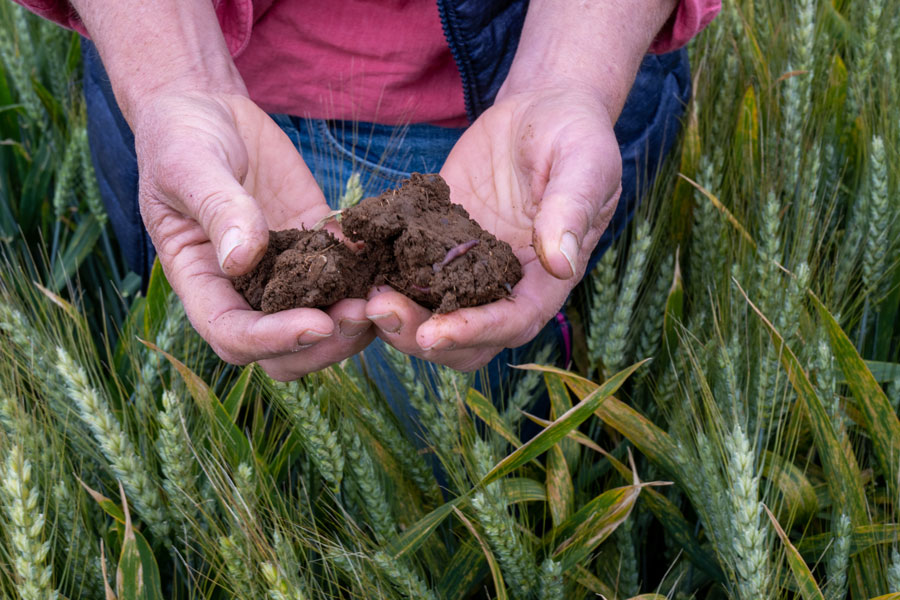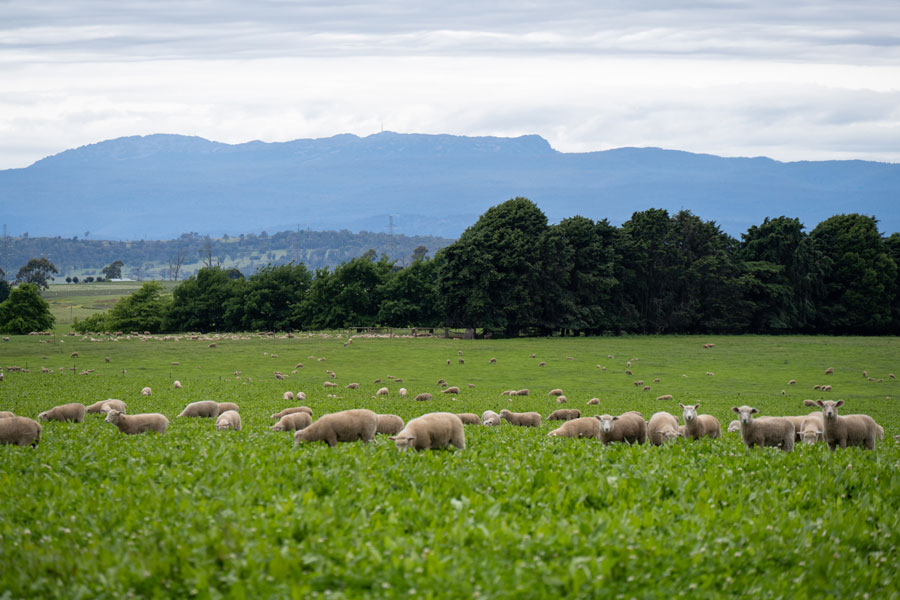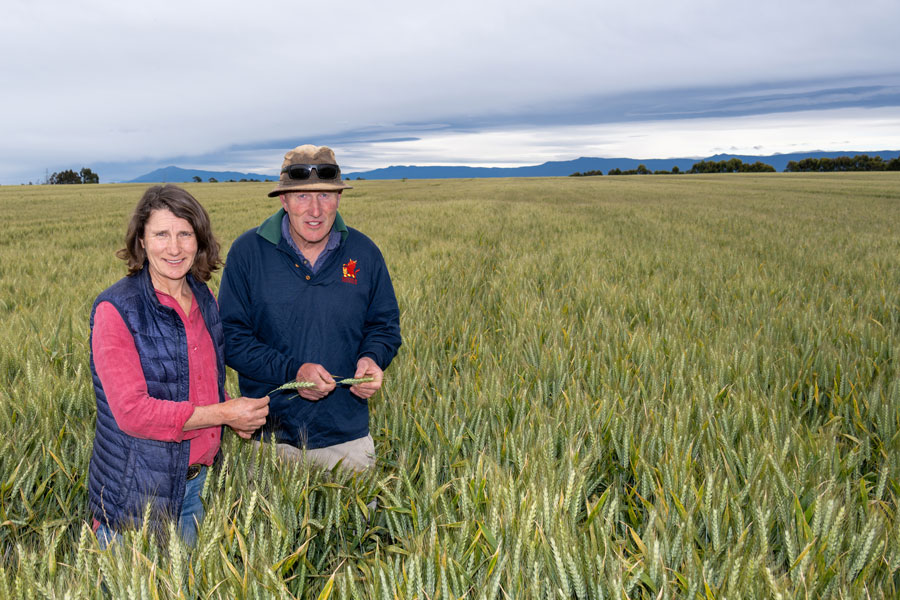While high rainfall provides Rob and Jo Bradley with a lot of opportunities, it also brings one of their biggest challenges – waterlogging.
“It’s our biggest limitation,” Rob says. “Our country gets quite heavy once you get down to the clay, and it holds a lot of moisture. We are always saturated coming out of winter.”
To counter the problem, Rob and Jo have been investing in underground drainage to combat waterlogging in the high-rainfall zone of Longford, Tasmania.
While it was apparent that adding drainage would be key to improving their paddocks, it can quickly become expensive. The Bradleys knew very early on that drainage would bring a vast improvement to their paddocks, but began the big project in earnest about seven years ago.

Jo Bradley shows the soil on part of a paddock where drains have been installed to reduce waterlogging on the farm she and her husband Rob run near Longford, Tasmania. Photo: Nicole Baxter
“We always knew it would work – the only thing that stopped us starting earlier is that it is a big investment,” Rob says. Therefore, Rob and Jo have adopted an approach to adding drainage that makes it a more manageable project.
“We were given two options: you can spend a heap of money and drain the whole lot, or you can just poke away at the bad patches because you don’t need to do it all. Because you don’t actually know all the bits that don’t need doing, so start slowly and patch your way through, and you can link up the drainage as you go.”
This approach, which they have dubbed ‘patch drainage’, has allowed the Bradleys to begin with the wettest parts of their paddocks, and slowly work towards improving the rest of the land as they have the resources to do so. “You start with the shockingly wet parts of the paddock, then that gets dry and beautiful and suddenly the next paddock up that you thought was dry looks wet in comparison.”
Rob and Jo have been putting in two different kinds of underground drainage in their paddocks. The first is mole drainage, which involves pulling a ‘torpedo’ (a ripper tyne with a cylindrical foot) through the clay layer to create channels that prevent water soaking deeper in the soils.
The larger investment has been in installing a subsurface pipe drainage system, where they have installed pipes about
800 millimetres under the soil surface with gravel placed over the top, which then catches the water and carries it out of the paddock.
“We have the pipes on a 20 to 30-metre grid, and then the moles are about 2m apart, as they are much cheaper to put in,” Rob says.
From this, there are three main benefits, Rob explains: timeliness, as having proper drainage allows him to get out on the paddocks faster; weed control, because the weeds grow in areas with poor crop coverage, so the waterlogged areas become hosts for weeds; and improved yield. Rob estimates the overall yield increase is about 10 to 20 per cent,
with a range of zero to 100 per cent.
“The difference is enormous. It’s expensive, but it’s a pretty easy sum to be honest. It’s not the sexiest thing farmers want to invest in, because there is nothing to see – it’s all underground. But you do see a dramatic crop response and have the satisfaction of seeing all the excess water pouring out of the pipe at the end of the paddock.”

Rob and Jo Bradleyʼs prime lambs on their farm near Longford, Tasmania. Photo: Nicole Baxter
As is typical of many Tasmanian growers, Rob and Jo Bradley have grown a diverse range of crops over the years. And as they continue to have a multi-faceted rotation, cereals have started to become a prominent part of their rotation again.
Currently, the Bradleys run a mixed sheep and cropping farm in Longford with sheep and pasture as well as a shared dairy farm nearby in Nile. However, it has been an ongoing journey to find what works well for them. Rob started farming in 1997 at Jo’s family farm, which focused on Merinos and wheat. As irrigation was introduced, the business expanded into poppy and pea production.
During this time the focus was on converting pastures into cropping land, as there was minimal value in livestock at the time. “Poppies basically built our business,” Rob says. “That’s where the capital development for all the centre pivots and irrigation development came from.”
For 13 years, Jo and Rob also farmed with Jo’s brother Bill, as well as Michael Chilvers, who died in 2021. The inspiration for growing cereals came from Michael’s work and influence, Rob says.
A need for change
However, issues with waterlogging and frost drove the Bradleys towards wanting to diversify their farming business again. This led to the purchase of the dairy property in 2008 that they continue to share-farm. This was one of the various moves the Bradleys were making in order to build a more sustainable business and farming practice.
“The whole idea of that was to diversify risk, which we’ve certainly done. But, at the same time, in some ways we were farming the land quite hard,” Rob says.
Realising their current intensive irrigated cropping program would not continue to be sustainable, Rob and Jo looked into more ways to build a sustainable farming system.
“We used to grow poppies with about two fungicides and one insecticide, and weed control was pretty easy. But towards the end of us growing big areas of poppies, the inputs had grown enormously,” he says.
“We had farmed out the easy bit, essentially, which was the lovely 50 years of permanent pasture and all the lovely organic matter that came with it. So, we had to start looking at how we could diversify and build a business that was more sustainable.”
Sustainable farming
Farming in a sustainable way has become a passion for both Rob and Jo. While he is now chair of the board of Nuffield Australia, Rob’s own Nuffield Scholarship in 2009 focused on finding a more sustainable way of farming and how an integrated cropping and livestock enterprise could be a way to build a more robust farming practice and business.
Separating from Jo’s family in 2010, Rob and Jo felt the need to incorporate livestock more into their cropping paddocks again, and began to finish crossbred lambs and build a ewe breeding flock. This allowed them to introduce more perennial crops into the system, which meant they could achieve better weed control and build organic matter.
“We’ve always kept livestock and crops mixing around. The paddock on our driveway is currently grass and clover. It will go from that to ryegrass seed crops, to wheat, to potatoes. It’s complex, it takes a lot of intensive management and there are a lot of compromises, but it really improves our soil quality.”
Making pasture phases a crucial part of the rotation has allowed the Bradleys to achieve organic matter numbers of 3.6 to 8.1 per cent. Rob notes that while this has been great for their farm, it does mean they cannot really take advantage of the soil carbon market. “We’ve already done the work,” he says. However, the results speak for themselves. “Our dairy business is a great example. It was really flogged country when we got it because they had just been growing potatoes on potatoes there. We’ve had permanent pastures on it for the past 12 years and have drained it. Now it looks sensational.”
Rotation
As they grow such a large variety of crops, refining their crop rotation has been a significant contributor to improving their soils and growing better cereal crops. While they have a lot of crops still in rotation, Rob says they have somewhat “simplified” it by growing larger areas of single crops.
Along with pasture stages building soil organic matter, potato crops leave a lot of nutrients behind from residual fertiliser, and ryegrass seed crops help with weed control.
“Our environment is very conducive to ryegrass as a weed. In drier environments it’s easier to get good control early, as we can get control early and then have another germination in July, then another one in September.”
Counterintuitively, ryegrass seed crops help control ryegrass as a weed. “Ryegrass seed crops are very aggressive in their growth patterns and are still susceptible to weed grass control. So, the crop outcompetes the more herbicide resistant mutations of ryegrass, essentially acting as a cover crop.”
Striving for improvement
Other factors that have allowed cereal crops to become a more prominent crop in the Bradleys’ rotation include improved drainage and improved agronomy.
“The varieties have improved, but I think more importantly our agronomy package has improved greatly. We know how to feed crops coming out of winter now, so we have gone from having miserable crops out of winter to having crops with good root systems ready to go.”
This, along with improved grain prices and the better production systems they have learnt means that cereals are becoming a much more prominent crop in their rotation. However, there are still some things Rob is looking for in new research.

Rob and Jo Bradley are gradually investing in drainage to address waterlogging issues at their Longford, Tasmania, property. Photo: Nicole Baxter
Along with waterlogging-tolerant varieties, he is also looking for new approaches to battling growing disease pressure. Controlling disease is becoming expensive and the timings are crucial,
he notes.
“Accroc’s disease resistance to stripe rust broke down this year. We had to do a seed dressing plus three fungicides. I’ve changed my attitude towards putting spray rigs in paddocks now – if they can go on there they just go – it doesn’t matter what tracks they leave behind.”
Jo and Rob are constantly striving to improve their farming practices, and in the process, they are improving the longevity of their land.
“Sustainability is what inspires me,” Jo says. “Having a farm that is healthy and cared for – I don’t like to see degradation.”
“What inspires me is just seeing constant improvement,” Rob says. “And it’s not necessarily development or financially driven, it’s just using your skill base to make things better.”
More information: Rob Bradley, robnjo4@bigpond.com

























































